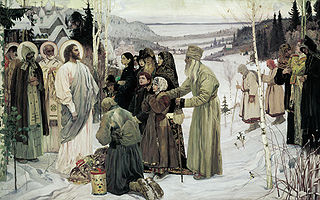Mikhail Nesterov
Mikhail Vasilyevich Nesterov | |
|---|---|
 Portrait by Viktor Vasnetsov | |
| Born | 31 May 1862 |
| Died | 18 October 1942 (aged 80) |
| Education | Moscow School of Painting, Sculpture and Architecture, Imperial Academy of Arts |
| Known for | Painter |
| Movement | Russian Symbolism |
Mikhail Vasilyevich Nesterov (Russian: Михаи́л Васи́льевич Не́стеров; 31 May [O.S. 19 May] 1862 – 18 October 1942) was a major representative of religious Symbolism in Russian art.
Biography
Mikhail Nesterov was a pupil of Pavel Chistyakov at the Imperial Academy of Arts, but later allied himself with the group of artists known as the Peredvizhniki. His canvas The Vision of the Youth Bartholomew (1890–91), depicting the conversion of medieval Russian Saint Sergei Radonezhsky, is often considered to be the earliest example of the Russian Symbolist style.
From 1890 to 1910, Nesterov lived in Kiev and Saint Petersburg, working on frescoes in St. Vladimir's Cathedral and the Church on Spilt Blood, respectively. After 1910, he spent the remainder of his life in Moscow, working in the Marfo-Mariinsky Convent. As a devout Orthodox Christian, he did not accept the Bolshevik Revolution but remained in Russia until his death, painting the portraits of Ivan Ilyin, Ivan Pavlov, Ksenia Derzhinskaya,[1] Otto Schmidt, and Vera Mukhina, among others.
Gallery
-
Holy Rus, 1901-06

-
Crucifixion, 1912
-
Taking the Veil, 1897-98
-
The Love Potion, 1888
-
The Vision to the Youth Bartholomew, 1889-1890
-
Beyond the Volga, 1905
-
Philosophers, 1917 (Depicts theologians Pavel Florensky and Sergei Bulgakov.)
-
Tolstoy, 1906 (Depicts Russian novelist Leo Tolstoy at his home in Moscow.)
-
Three old men with a fox, 1914
See also
Notes
- ^ Derzhinskaia Ksenia Georgievna (1889-1951), cousin of the musicologist Alexander Ossovsky and the composer Mykola Vilinsky, outstanding Russian singer, also professor at Moscow Conservatory (1947-51), was called "Golden Soprano of Bolshoi Theatre"[1], also see Sergei Rachmaninoff
External links
 Media related to Mikhail Nesterov at Wikimedia Commons
Media related to Mikhail Nesterov at Wikimedia Commons- Detailed biography Template:Ru icon
- Online Nesterov gallery Template:En icon
- 1862 births
- 1942 deaths
- People from Ufa
- People from Orenburg Governorate
- Russian artists
- Russian realist painters
- 19th-century Russian painters
- 20th-century Russian painters
- Russian portrait painters
- Russian genre painters
- Russian landscape painters
- Peredvizhniki
- Symbolist painters
- Christian artists
- Members of the Union of the Russian People
- Stalin Prize winners
- Recipients of the Order of the Red Banner of Labour
- Soviet realist painters









